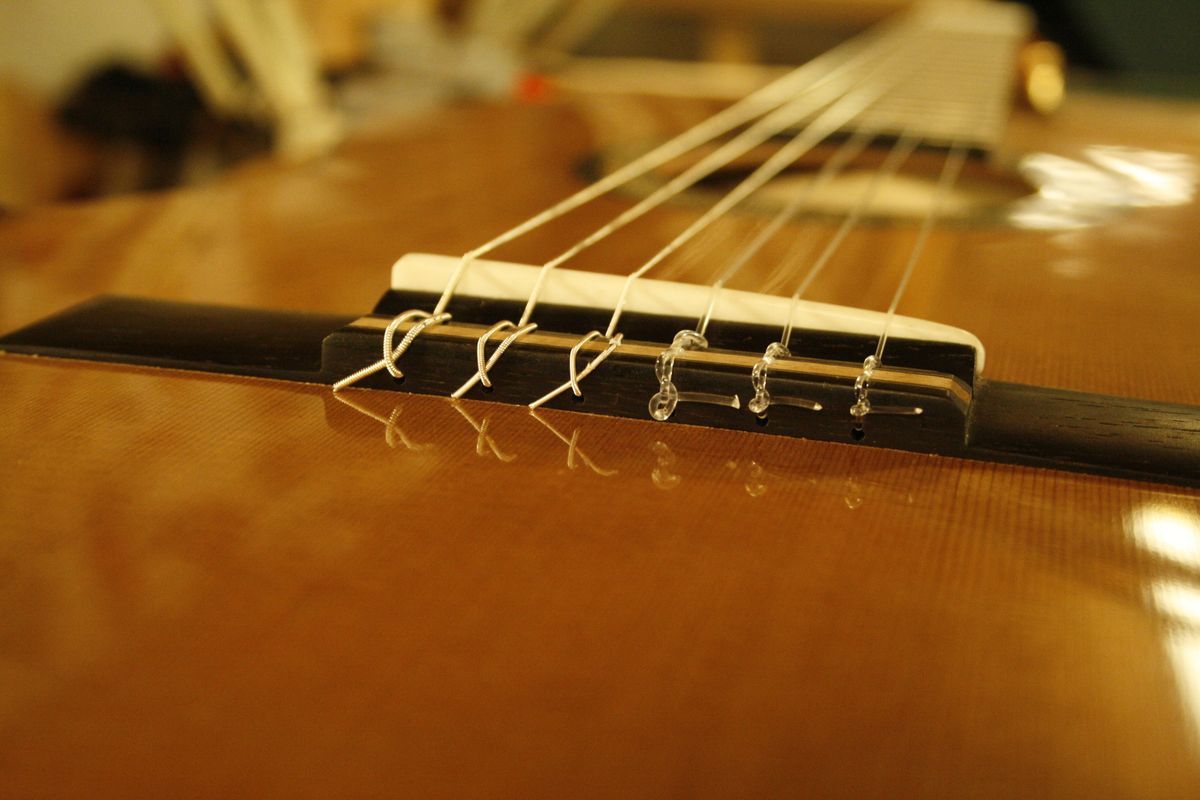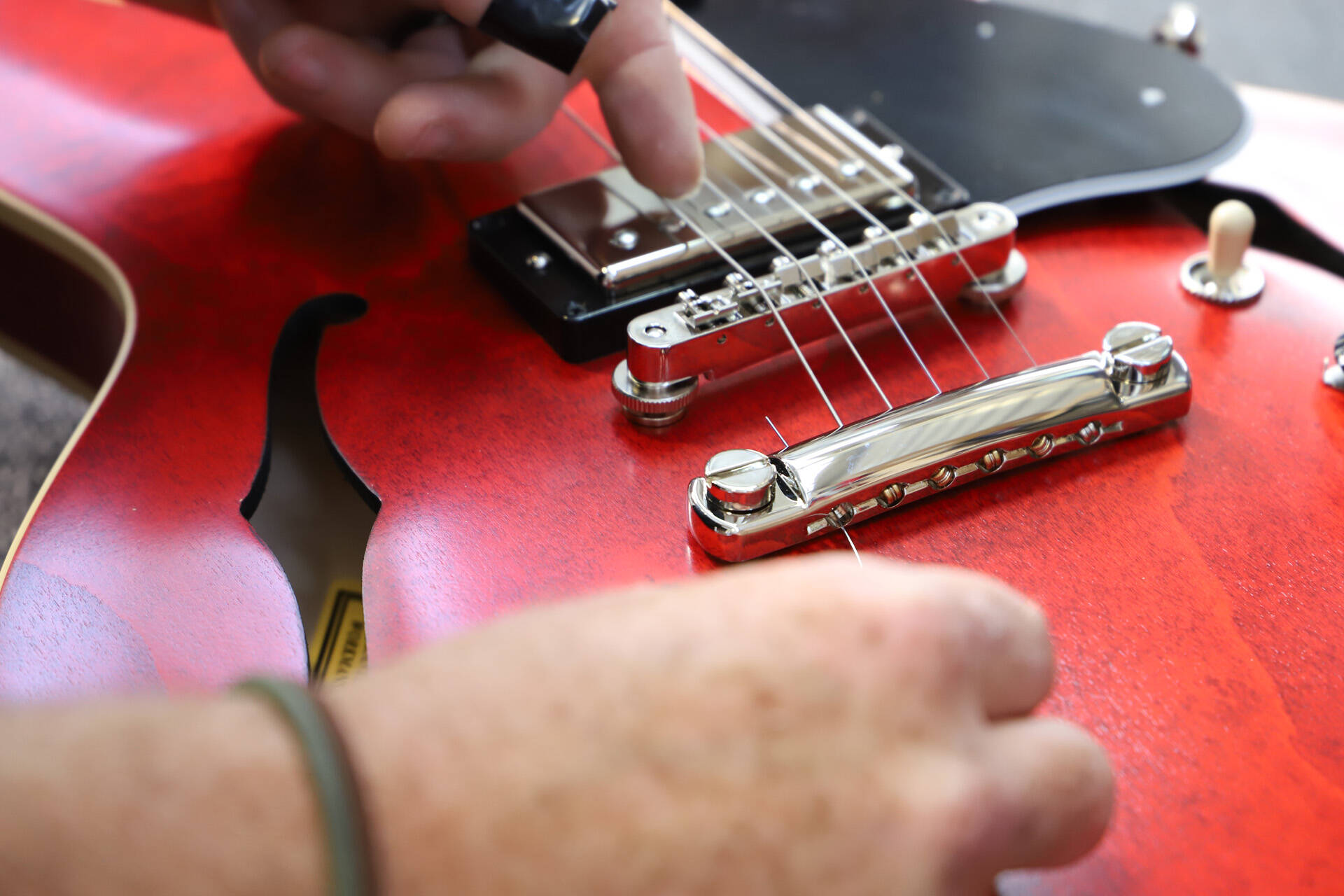Home>Instruments>Guitar>How To Play A 12-String Guitar


Guitar
How To Play A 12-String Guitar
Published: February 13, 2024
Learn how to play a 12-string guitar with our expert tips and tutorials. Master the art of playing the guitar and elevate your musical skills.
(Many of the links in this article redirect to a specific reviewed product. Your purchase of these products through affiliate links helps to generate commission for AudioLover.com, at no extra cost. Learn more)
Table of Contents
Introduction
Playing the 12-string guitar is a unique and rewarding experience that adds a rich, resonant depth to your music. While similar in structure to the standard 6-string guitar, the 12-string guitar features double courses of strings, creating a lush, harmonic sound that's distinctive and captivating. Whether you're a seasoned guitarist or just starting your musical journey, mastering the 12-string guitar opens up a world of sonic possibilities.
In this comprehensive guide, we'll delve into the intricacies of the 12-string guitar, from understanding its construction and tuning to exploring various playing techniques and common chord progressions. Additionally, we'll provide valuable tips to help you harness the full potential of this instrument, allowing you to elevate your musical expression to new heights.
For those new to the 12-string guitar, fear not. While it may seem daunting at first, the rewards of mastering this instrument are well worth the effort. The unique sound and resonance of the 12-string guitar have been featured in a myriad of iconic songs across diverse musical genres, showcasing its versatility and appeal. Whether you're drawn to folk, rock, blues, or beyond, the 12-string guitar has found its place in the fabric of modern music, adding depth and dimension to countless compositions.
Throughout this guide, we'll provide insights and techniques to help you navigate the intricacies of the 12-string guitar, empowering you to unlock its full potential. So, grab your 12-string guitar, and let's embark on this musical journey together, discovering the beauty and allure of this remarkable instrument.
Understanding the 12-String Guitar
The 12-string guitar is a marvel of musical engineering, distinguished by its doubled string courses that produce a lush, resonant sound. Unlike the standard 6-string guitar, the 12-string guitar features pairs of strings for each of the six traditional strings. The lower-pitched string in each pair is typically tuned to the standard pitch, while the higher-pitched string is tuned an octave higher. This unique construction results in a fuller, more complex sound that adds depth and dimension to your music.
One of the defining characteristics of the 12-string guitar is its rich harmonic quality. When strummed, the doubled strings create a chorus-like effect, filling the sonic space with a shimmering, ethereal resonance. This distinctive sound has made the 12-string guitar a popular choice for musicians seeking to add a captivating and immersive quality to their compositions.
From a structural standpoint, the 12-string guitar is often slightly larger than its 6-string counterpart to accommodate the additional strings. The neck may also be wider to accommodate the doubled string courses, requiring a slight adjustment in playing technique for those accustomed to the standard guitar. Additionally, the tension exerted by the doubled strings may necessitate a slightly different approach to fretting and strumming, but with practice, these nuances can be seamlessly integrated into your playing style.
Understanding the unique tonal characteristics and physical attributes of the 12-string guitar is essential for harnessing its full potential. Whether you’re drawn to its captivating sound or intrigued by its historical significance in various musical genres, the 12-string guitar offers a wealth of sonic possibilities for musicians and enthusiasts alike.
Tuning the 12-String Guitar
Tuning a 12-string guitar is a crucial step in unlocking its captivating sound. The doubled string courses introduce a unique tuning process that differs from the standard 6-string guitar. The traditional tuning for a 12-string guitar involves pairing each string with a higher-pitched octave string, creating a lush and resonant sonic landscape.
The most common tuning for a 12-string guitar is known as “standard tuning,” where the six string pairs are tuned to E, A, D, G, B, and E. The lower-pitched string in each pair is tuned to the standard pitch, while the higher-pitched string is tuned to the octave above. This tuning configuration enhances the instrument’s rich, harmonic character, contributing to its distinctive and immersive sound.
When tuning a 12-string guitar, it’s essential to ensure that the paired strings are in harmony with each other. This involves carefully adjusting the tension of each string pair to achieve the desired pitch and octave relationship. Utilizing an electronic tuner can greatly facilitate this process, providing precise guidance to achieve accurate tuning across all string pairs.
While standard tuning is the most prevalent, there are alternative tunings that can further expand the sonic palette of the 12-string guitar. These alternate tunings offer unique tonal possibilities, allowing musicians to explore different chord voicings, resonances, and textures. Some popular alternate tunings for the 12-string guitar include DADGAD, open D, and open G, each offering its own distinct sonic landscape to inspire creative exploration.
Mastering the art of tuning a 12-string guitar is essential for harnessing its full potential. Whether you’re drawn to the lush, harmonic sound of standard tuning or eager to explore alternate tunings for a more experimental approach, the process of tuning is a gateway to unlocking the captivating sonic capabilities of the 12-string guitar.
Playing Techniques
Playing the 12-string guitar presents a unique set of techniques and considerations that differ from those of a standard 6-string guitar. The doubled string courses and rich harmonic resonance of the 12-string guitar require a nuanced approach to playing, encompassing both strumming and fingerstyle techniques.
When strumming a 12-string guitar, it’s essential to maintain a fluid and even motion to ensure that both strings in each course are sounded simultaneously. This technique contributes to the instrument’s lush, chorus-like effect, creating a captivating sonic texture that distinguishes the 12-string guitar from its 6-string counterpart. Additionally, experimenting with varying degrees of strumming intensity can yield a dynamic range of tonal expression, allowing you to harness the instrument’s full sonic potential.
For those inclined towards fingerstyle playing, the 12-string guitar offers a wealth of expressive possibilities. The doubled string courses can be leveraged to create intricate and resonant fingerstyle arrangements, with the octave strings adding depth and complexity to the melodic and harmonic elements of your playing. Employing techniques such as arpeggios, harmonics, and alternate tunings can further enhance the instrument’s evocative qualities, inviting a diverse range of musical exploration.
It’s important to note that the increased tension exerted by the doubled strings may require a slight adjustment in finger pressure and fretting technique, particularly for those accustomed to playing a standard 6-string guitar. However, with practice and familiarity, these adjustments can become second nature, allowing you to fully embrace the expressive potential of the 12-string guitar.
Ultimately, mastering the playing techniques of the 12-string guitar is a journey of discovery and expression. Whether you’re drawn to the immersive sound of strumming or the intricate nuances of fingerstyle playing, the 12-string guitar offers a rich and resonant canvas for musical creativity, inviting you to explore new sonic horizons and elevate your playing to captivating heights.
Common Chord Progressions
Exploring common chord progressions on the 12-string guitar unveils the instrument’s capacity for creating lush, harmonically rich soundscapes across various musical genres. The doubled string courses and resonant tonal characteristics of the 12-string guitar lend themselves to a diverse range of chord progressions, each imbued with a captivating and immersive quality.
One prevalent chord progression that resonates profoundly on the 12-string guitar is the classic I-IV-V progression. In the key of G, for instance, this progression comprises the chords G, C, and D, delivering a robust and resonant foundation that showcases the instrument’s harmonic depth. When strummed or fingerpicked on a 12-string guitar, these chords resonate with a captivating lushness, filling the sonic space with a rich, immersive quality.
Additionally, the ethereal sound of the 12-string guitar lends itself beautifully to modal chord progressions, such as those found in folk and world music traditions. Modal progressions, like the use of DADGAD tuning in Celtic music, or open tunings in blues and rock, can evoke a haunting and evocative ambiance when rendered on the 12-string guitar, enriching the musical narrative with a profound sense of depth and resonance.
Furthermore, the 12-string guitar’s capacity for creating intricate and resonant fingerstyle arrangements enhances the exploration of chord progressions, allowing for the seamless integration of melodic and harmonic elements. The doubled strings add a compelling complexity to arpeggiated chords and harmonic embellishments, enriching the tonal tapestry and infusing the progressions with a captivating and immersive quality.
Exploring common chord progressions on the 12-string guitar unveils a world of sonic possibilities, inviting musicians to immerse themselves in the instrument’s rich harmonic landscape. Whether delving into traditional progressions or venturing into more experimental territories, the 12-string guitar offers a captivating canvas for musical expression, enriching compositions with its lush, resonant, and evocative sound.
Tips for Playing the 12-String Guitar
Mastering the art of playing the 12-string guitar requires a blend of technical proficiency, nuanced understanding, and a deep appreciation for its unique sonic qualities. Here are some valuable tips to enhance your experience and proficiency when playing this captivating instrument:
- Develop Finger Strength and Dexterity: Given the doubled string courses and increased tension, developing finger strength and dexterity is crucial. Regular practice and exercises tailored to strengthen the fingers and improve agility can greatly enhance your playing ability on the 12-string guitar.
- Focus on Precision Tuning: Due to the doubled strings, precise tuning is essential to ensure a harmonious and resonant sound. Utilize an electronic tuner and regularly check the tuning to maintain the instrument’s captivating tonal qualities.
- Experiment with Different Playing Styles: Embrace the versatility of the 12-string guitar by exploring various playing styles, including strumming, fingerstyle, and hybrid techniques. Each approach offers unique sonic possibilities, enriching your musical expression.
- Be Mindful of String Tension: The increased string tension of the 12-string guitar requires a nuanced approach to fretting and strumming. Be mindful of the pressure exerted on the strings to achieve optimal tone and minimize discomfort during extended playing sessions.
- Explore Alternate Tunings: Venture into alternate tunings to expand your sonic palette and discover new creative avenues. Experimenting with alternate tunings can yield unique chord voicings and resonances, adding depth and complexity to your compositions.
- Embrace Dynamics and Expression: Leverage the 12-string guitar’s capacity for dynamic range and expressive depth. Explore varying degrees of strumming intensity, nuanced fingerstyle articulation, and subtle tonal modulations to imbue your playing with captivating dynamics and emotion.
- Practice Patience and Persistence: Mastering the 12-string guitar is a journey that requires patience and persistence. Embrace the learning process, celebrate small victories, and maintain a dedicated practice regimen to continually refine your skills and musical expression.
By incorporating these tips into your practice and playing routine, you can enhance your proficiency and enjoyment of the 12-string guitar, unlocking its boundless potential for creative expression and sonic exploration.
Conclusion
In conclusion, the 12-string guitar stands as a captivating and immersive instrument that enriches musical compositions with its lush, resonant sound and harmonic depth. From its unique construction and tuning to the diverse playing techniques and sonic possibilities it offers, the 12-string guitar embodies a rich heritage and continues to captivate musicians and audiences across various genres.
Mastering the art of playing the 12-string guitar requires dedication, patience, and a deep appreciation for its distinctive sonic qualities. Whether strumming resonant chords, crafting intricate fingerstyle arrangements, or exploring alternate tunings, the 12-string guitar invites musicians to embark on a journey of creative expression, harnessing its captivating tonal landscape to weave compelling musical narratives.
As you delve into the realm of the 12-string guitar, remember to embrace the instrument’s unique characteristics, from its doubled string courses to its ethereal resonance. Develop finger strength and precision, explore different playing styles, and remain open to the boundless sonic possibilities that the 12-string guitar presents.
Ultimately, the 12-string guitar serves as a gateway to a world of musical exploration, inviting you to infuse your compositions with depth, emotion, and evocative resonance. Whether you’re drawn to folk, rock, blues, or beyond, the 12-string guitar offers a captivating canvas for sonic expression, enriching your musical journey with its immersive and enchanting sound.
So, pick up your 12-string guitar, embrace its harmonic allure, and embark on a musical odyssey that transcends boundaries and resonates with timeless beauty and depth.











